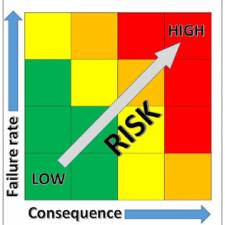2.1 Electrolysis
The movement of ions of opposite polarities in opposite directions through a medium is called electrolysis and can be made to occur by passing DC current through body tissues or fluids. If a DC current is passed through body tissues for a period of minutes, ulceration begins to occur. Such ulcers, while not normally fatal, can be painful and take long periods to heal.
2.2 Burns
When an electric current passes through any substance having electrical resistance, heat is produced. The amount of heat depends on the power dissipated (I2R). Whether or not the heat produces a burn depends on the current density.
Human tissue is capable of carrying electric current quite successfully. Skin normally has a fairly high electrical resistance while the moist tissue underneath the skin has a much lower resistance. Electrical burns often produce their most marked effects near to the skin, although it is fairly common for internal electrical burns to be produced, which, if not fatal, can cause long lasting and painful injury.
2.3 Muscle cramps
When an electrical stimulus is applied to a motor nerve or a muscle, the muscle does exactly what it is designed to do in the presence of such a stimulus i.e. it contracts. The prolonged involuntary contraction of muscles (tetanus) caused by an external electrical stimulus is responsible for the phenomenon where a person who is holding an electrically live object can be unable to let go.
2.4 Respiratory arrest
The muscles between the ribs (intercostal muscles) need to repeatedly contract and relax in order to facilitate breathing. Prolonged tetanus of these muscles can therefore prevent breathing.
2.5 Cardiac arrest
The heart is a muscular organ, which needs to be able to contract and relax repetitively in order to perform its function as a pump for the blood. Tetanus of the heart musculature will prevent the pumping process.
2.6 Ventricular fibrillation
The ventricles of the heart are the chambers responsible for pumping blood out of the heart. When the heart is in ventricular fibrillation, the musculature of the ventricles undergoes irregular, uncoordinated twitching resulting in no net blood flow. The condition proves fatal if not corrected in a very short space of time.
Ventricular fibrillation can be triggered by very small electrical stimuli. A current as low as 70 mA flowing from hand to hand across the chest, or 20µA directly through the heart may be sufficient. It is for this reason that most deaths from electric shock are attributable to the occurrence of ventricular fibrillation.
2.7 Effect of frequency on neuro-muscular stimulation
The amount of current required to stimulate muscles is dependent to some extent on frequency. Referring to figure 1, it can be seen that the smallest current required to prevent the release of an electrically live object occurs at a frequency of around 50 Hz. Above 10 kHz the neuro-muscular response to current decreases almost exponentially.
 Figure 1. Current required to prevent release of a live object.
Figure 1. Current required to prevent release of a live object.
2.8 Natural protection factors
Many people have received electric shocks from mains potentials and above and lived to tell the tale. Part of the reason for this is the existence of certain natural protection factors.
Ordinarily, a person subject to an unexpected electrical stimulus is protected to some extent by automatic and intentional reflex actions. The automatic contraction of muscles on receiving an electrical stimulus often acts to disconnect the person from the source of the stimulus. Intentional reactions of the person receiving the shock normally serve the same purpose. It is important to realise that a patient in the clinical environment who may have electrical equipment intentionally connected to them and may also be anaesthetised is relatively unprotected by these mechanisms.
Normally, a person who is subject to an electric shock receives the shock through the skin, which has a high electrical resistance compared to the moist body tissues below, and hence serves to reduce the amount of current that would otherwise flow. Again, a patient does not necessarily enjoy the same degree of protection. The resistance of the skin may intentionally have been lowered in order to allow good connections of monitoring electrodes to be made or, in the case of a patient undergoing surgery, there may be no skin present in the current path.
The absence of natural protection factors as described above highlights the need for stringent electrical safety specifications for medical electrical equipment and for routine test and inspection regimes aimed at verifying electrical safety.








